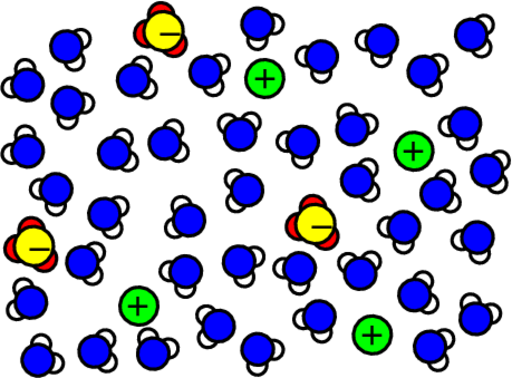Research topics
Fundamental tribology theory
Friction is so ubiquitous in everyday life that we often don't even think about it. In industrialised societies, a great deal of energy and material is lost due to friction, and friction and wear are extremely important in the operation of all devices with moving parts. Humans have been dealing with friction since prehistoric times, and we have developed phenomenological laws to describe it. Nevertheless, we still do not fully understand these laws and their coefficients. As a result, attempts to engineer low-friction surfaces or effective lubricants are often based on trial and error.
 One of the main reasons why friction is such a challenging subject, is because many different effects occur at different scales. While two sliding surfaces appear flat on macroscopic scales, they are in fact almost never truly flat. On smaller scales, the roughness of the surfaces means that the actual contact area is small compared to the apparent contact area. The actual contacts are of the order of micrometer in size. Energy is dissipated in a variety of ways at these contacts by atomic interaction that occur on the scale of a nanometer. To understand friction on large, macroscopic scales, we must first understand friction on micro and nanometer scales. (The study of friction on very small scales is called nanotribology.)
During the last few decades, there have been enormous developments in experimental techniques for probing friction on small scales, such as the atomic force microscope (AFM), but theoretical understanding is lagging behind.
Theoretical techniques have also undergone developments: the mathematical understanding of dynamical systems as well as the massive increases in computing power have handed us the tools we need to finally understand friction.
In our group, we study and model friction on this basic level.
We employ detailed atomistic simulations as well, but our main focus here is on fundamental (qualitative, general) understanding and relatively simple models that contain the essential dynamics.
We are for example interested in the behaviour of solid lubricants, molecules adsorbed on sliding surfaces, and structure of polymers.
One of the main reasons why friction is such a challenging subject, is because many different effects occur at different scales. While two sliding surfaces appear flat on macroscopic scales, they are in fact almost never truly flat. On smaller scales, the roughness of the surfaces means that the actual contact area is small compared to the apparent contact area. The actual contacts are of the order of micrometer in size. Energy is dissipated in a variety of ways at these contacts by atomic interaction that occur on the scale of a nanometer. To understand friction on large, macroscopic scales, we must first understand friction on micro and nanometer scales. (The study of friction on very small scales is called nanotribology.)
During the last few decades, there have been enormous developments in experimental techniques for probing friction on small scales, such as the atomic force microscope (AFM), but theoretical understanding is lagging behind.
Theoretical techniques have also undergone developments: the mathematical understanding of dynamical systems as well as the massive increases in computing power have handed us the tools we need to finally understand friction.
In our group, we study and model friction on this basic level.
We employ detailed atomistic simulations as well, but our main focus here is on fundamental (qualitative, general) understanding and relatively simple models that contain the essential dynamics.
We are for example interested in the behaviour of solid lubricants, molecules adsorbed on sliding surfaces, and structure of polymers.

Nano-scale systems
Nanoscale systems are becoming more and more experimentally accessible, due to advances in microscopic manipulation and measurement techniques. Nano-scale friction experiments, using Atomic Force Microscopes for example, provide an especially useful window into transport of mass, energy, and momentum in nanoscale systems. Conceptually, these systems are challenging, because fluctuations are large, which means the systems are by definition out of equilibrium, and surface effects can dominate over bulk effects. Theoretical approaches are there often limited to numerical simulations. Stochastic thermodynamics and dynamical systems theory are the most promising basis for understanding the mechanics of nanosystems. Besides nano-scale friction, we also study other mechanical properties related to the nanoscale structure of materials.

Applied kinetic theory
Accurate values for transport coefficients such as the viscosity of complex gases and liquids are needed in many practical applications. The viscosity of a liquids, for example, is the key to lubrication. Real liquids are challenging, because of complicated interactions (such as in the case of electrolytes) and rich variety of geometries of the molecules. This often makes numerical simulations difficult and inefficient. There is only one usable analytical theoretical approach for turning detailed knowledge of the interactions between molecules into transport coefficients of fluids such as the shear viscosity: kinetic theory of gases and liquids. Nevertheless, it is notoriously difficult to obtain accurate results for transport coefficients of any but the simplest systems. Our objective is to develop new kinetic approaches to transport coefficients such as viscosity and diffusion of liquids and gases.

Miscellaneous
We sometimes stray into other fields.
The tools of statistical mechanics can be applied to other "particles" than atoms or molecules. We have applied them to biophysics, network science, social science, and other areas. What interests us is how the small-scale dynamics of individual "particles" can be linked to collective behaviour on larger scales, such as drug resistance developing in cells that are part of a larger tumor, cascading failures in networks, changing opinions and behaviour in interacting social groups.
Other field of interests are glasses, high-dimensional chaos, data mining and AI for engineering tribology, and strongly-correlated electron systems.